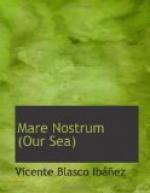The town did not abound in famous edifices. The monarchs of Naples had generally been foreigners who had resided far away and had governed through their delegates. The best streets, the palaces, the monumental fountain, had come from the Spanish viceroys. A sovereign of mixed origin, Charles the III, Castilian by birth and Neapolitan at heart, had done the most for the city. His building enthusiasm had embellished the ancient districts with works similar to those that he erected years afterward, upon occupying the throne of Spain.
After admiring the Grecian statuary in the museum, and the excavated objects that revealed the intimate life of the ancients, Ulysses threaded the tortuous and often gloomy arteries of the popular districts.
There were streets clinging to the slopes forming landings flanked with narrow and very high houses. Every vacant space had its balconies, and from every railing to its opposite were extended lines spread with clothes of different colors, hung out to dry. Neapolitan fertility made these little alleys seethe with people. Around the open-air kitchens there crowded patrons, eating, while standing, their boiled macaroni or bits of meat.
The hucksters were hawking their goods with melodious, song-like cries, and cords to which little baskets were fastened were lowered down to them from balconies. The bargaining and purchases reached from the depth of the street gutters to the top of the seventh floor, but the flocks of goats climbed the winding steps with their customary agility in order to be milked at the various stair landings.
The wharves of the Marinela attracted the captain because of the local color of this Mediterranean port. Italian unity had torn down and reconstructed much of it, but there still remained standing various rows of little low-roofed houses with white or pink facades, green doors, and lower floors further forward than the upper ones, serving as props for galleries with wooden balustrades. Everything there that was not of brick was of clumsy carpentry resembling the work of ship calkers. Iron did not exist in these terrestrial constructions suggestive of the sailboat whose rooms were as dark as staterooms. Through the windows could be seen great conch-shells upon the chests of drawers, harsh and childish oil paintings representing frigates, and multi-colored shells from distant seas.
These dwellings repeated themselves in all the ports of the Mediterranean just as though they were the work of the same hand. As a child, Ferragut had seen them in the Grao of Valencia and continually ran across them in Barcelona, in the suburbs of Marseilles, in old Nice, in the ports of the western islands, and in the sections of the African coast occupied by Maltese and Sicilians.
Over the town, lined up along the Marinela, the churches of Naples reared their domes and towers with glazed roofs, green and yellow, which appeared more like pinnacles of Oriental baths than the roofs of Christian temples.




